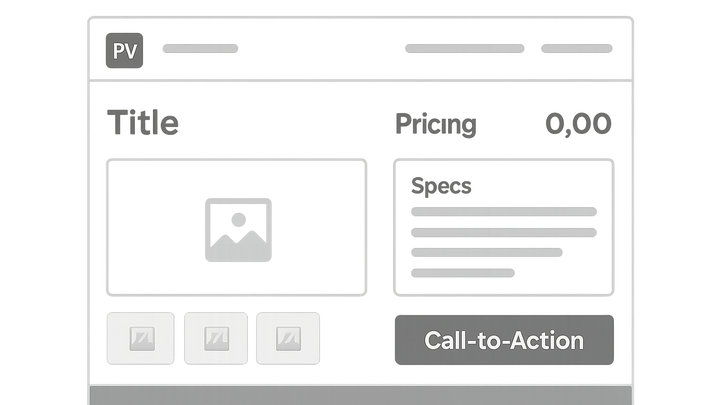Published on 2025-06-29T21:47:02Z
What are Product Page Specifications? Examples for Optimized Product Pages
Product Page Specifications are a comprehensive set of requirements and guidelines that dictate every aspect of an e-commerce product page, from content hierarchy and visual design to functional elements and SEO considerations. They ensure consistency across products, streamline development workflows, and align pages with CRO, UX, and SEO goals. By defining each component—such as titles, images, feature lists, technical specs, pricing, and call-to-action elements—teams can deliver a coherent user experience that maximizes conversions and satisfies accessibility standards. Good specifications also facilitate collaboration between marketing, design, and engineering teams, reduce revisions, and speed up time-to-market. Leveraging tools like Prevue.me can automate the critique process, providing data-driven recommendations to refine and validate your specifications.
Product page specifications
Structured guidelines defining content, layout, and functionality of product pages for optimal CRO, UX, and SEO.
Overview of Product Page Specifications
Product Page Specifications define the blueprint for how each product page should look, sound, and perform. They serve as a single source of truth, ensuring that all stakeholders share the same expectations and standards. Robust specifications are essential to maintain brand consistency, improve user trust, and boost search engine visibility.
-
Definition and purpose
A detailed outline of required elements—such as headings, descriptions, and functional modules—to ensure pages meet business objectives.
-
Importance for cro, ux, and seo
- Ensures consistent user pathways, reducing friction.
- Standardizes metadata and heading structures for better SEO.
- Improves accessibility and usability, enhancing user satisfaction.
Key Components
This section breaks down every critical element to include in your product page specifications, ensuring no detail is overlooked.
-
Product title & description
Guidelines to craft clear, concise, and keyword-optimized titles and descriptions.
- Length & keywords:
Limit titles to 60 characters and integrate primary keywords early for SEO.
- Structured descriptions:
Use short paragraphs and bullet points to highlight benefits and features.
- Length & keywords:
-
Images & media
Standards for visual content to ensure consistency, performance, and accessibility.
- Image quality:
Use high-resolution images (min 800×800 pixels) compressed for fast loading.
- Alt text & captions:
Provide descriptive alt text and captions to improve SEO and accessibility.
- Image quality:
-
Feature & specification list
Requirements for presenting product features and technical details.
- Format:
Present specs in a table or bulleted list for scannability.
- Detail level:
Include material, dimensions, weight, and other relevant attributes.
- Format:
-
Pricing, variants & inventory
Define how pricing, product variants, and stock information should be displayed.
- Variant selection:
Show clear options for colors, sizes, or configurations.
- Stock indicators:
Display real-time availability or back-in-stock notifications.
- Variant selection:
-
Call-to-action & trust signals
Standards for buttons, badges, and social proof to drive conversions.
- Cta design:
Use a prominent color contrast and clear action text like ‘Buy Now’.
- Trust badges:
Include security seals, customer reviews, and guarantee statements.
- Cta design:
-
Performance & accessibility
Criteria to ensure fast loading times and compliance with WCAG guidelines.
- Page speed:
Aim for <3s load time; lazy-load offscreen images.
- Accessibility standards:
Ensure keyboard navigation, proper ARIA labels, and color contrast ratios.
- Page speed:
Automating Reviews with Prevue.me
Leverage prevue.me to perform automated critiques of your product pages and refine your specifications based on actionable insights.
-
Submitting your page for analysis
Enter your product page URL into prevue.me to receive a comprehensive report covering CRO, SEO, UX, and accessibility.
-
Interpreting recommendations
Use prioritized action items—such as improving heading structures or compressing images—to update your specifications document.
-
Iterative testing
Track changes over time by re-running analyses after each update to measure impact.
Example Product Page Specification Template
Use this HTML snippet as a starting point for your own documentation. Adapt IDs and comments to match your product catalog.
-
Html template snippet
<!-- Product Page Specification Template --> <section id=product-title> <!-- Title: Max 60 chars, include primary keyword --> </section> <section id=product-gallery> <!-- 3-5 high-res images, alt text required --> </section> <section id=product-features> <!-- Bullet-point list: max 8 items, highlight top benefits --> </section> <section id=product-specs> <!-- Table: attribute on left, value on right (e.g., weight, dimensions) --> </section> <section id=pricing> <!-- Base price, variants, and discounts --> </section> <section id=cta> <!-- Button: 'Buy Now', primary color #007BFF --> </section> <!-- Accessibility: alt text for images; color contrast >= 4.5:1 -->
